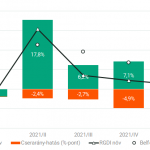
 The closer the better: does better access to outpatient care prevent hospitalization? – címmel megjelent Elek Péter tudományos munkatárs Molnár Tamással és Váradi Balázzsal írt közös cikke a The European Journal of Health Economics folyóiratban.
The closer the better: does better access to outpatient care prevent hospitalization? – címmel megjelent Elek Péter tudományos munkatárs Molnár Tamással és Váradi Balázzsal írt közös cikke a The European Journal of Health Economics folyóiratban.
Abstract
In 2010–2012, new outpatient service locations were established in poor Hungarian micro-regions. We exploit this quasi-experiment to estimate the extent of substitution between outpatient and inpatient care. Fixed-effects Poisson models on individual-level panel data for years 2008–2015 show that the number of outpatient visits increased by 19% and the number of inpatient stays decreased by 1.6% as a result, driven by a marked reduction of potentially avoidable hospitalization (PAH) (5%). In our dynamic specification, PAH effects occur in the year after the treatment, whereas non-PAH only decreases with a multi-year lag. The instrumental variable estimates suggest that a one euro increase in outpatient care expenditures produces a 0.6 euro decrease in inpatient care expenditures. Our results (1) strengthen the claim that bringing outpatient care closer to a previously underserved population yields considerable health benefits, and (2) suggest that there is a strong substitution element between outpatient and inpatient care.
Nem található esemény a közeljövőben.
A KRTK Közgazdaság-tudományi Intézet teljesítményéről A KRTK KTI a RePEc/IDEAS rangsorában, amely a világ közgazdaság-tudományi tanszékeit és intézeteit rangsorolja publikációs teljesítményük alapján, a legjobb ... Read More »

Tisztelt Kollégák! Tudományos kutatóként, intézeti vezetőként egész életünkben a kutatói szabadság és felelősség elve vezetett bennünket. Meggyőződésünk, hogy a tudomány csak akkor érhet el ... Read More »

Srí Lanka: a 2022-es gazdasági válság leckéje – A. Krueger Lessons from Sri Lanka Anne O. Krueger Jul 25, 2022 – Project Syndicate ... Read More »

A permanens válság korában élünk – J. Meadway We’re living in an age of permanent crisis – let’s stop planning for a ‘return ... Read More »

A 2021 végén, illetve 2022 elején tapaszalt 6, illetve 7%-os cserearányromlás brutális reáljövedelem-kivonást jelentett a magyar gazdaságból. A külső egyensúly alakulásával foglalkozó elemzések többnyire ... Read More »
